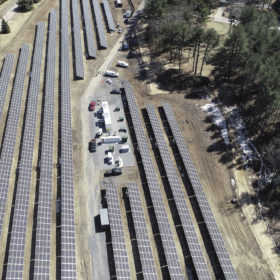California introduces bill to accelerate heat pump adoption
With California projected to fall two million installations short of its 2030 target, the bill aims to make installing heat pumps and HVAC systems faster and easier.
The challenge of truly clean-powered operations
Growing corporate interest in hourly matching power purchase agreements (PPAs) is expected to drive the pairing of PV, wind, and battery energy storage systems (BESS), with potential broader impacts on the energy procurement market, as Neil Ford reports.
Are robots coming for solar installer jobs?
Robots on solar sites are not new; they have been deployed to automate everything from operations and maintenance to inspection and cleaning. In recent months, there has been an uptick in interest in robots for installation, particularly among utility-scale solar developers dealing with staff shortages, safety concerns, rising costs, and pressure to build.
California solar on canals initiative moves forward
The California Solar Canal Initiative (CSCI) aims to use research from the University of California, Merced, to find communities willing to generate power with solar-covered canals.
The Hydrogen Stream: HyIron starts green hydrogen production in Namibia
HyIron says it has produced the first green hydrogen molecules at its Namibian facility, while Copenhagen Infrastructure Partners (CIP) has secured AUD 814 million ($512 million) for its Murchison Green Hydrogen project in Western Australia.
Rooftop solar saved California ratepayers $1.5 billion last year
Rooftop solar saved California ratepayers $1.5 billion in 2023, but state regulators argue it imposed an $8.5 billion cost. A new report challenges that claim, citing calculation errors and overlooked benefits.
Rebuild fire-devastated homes all-electric with solar
Stanford University professor Mark Z. Jacobson explains how the areas of Los Angeles that were recently hit by fire have now the opportunity to reduce energy bills and reconstruction costs by rebuilding only all-electric homes. “There is no reason to have both electricity and fossil gas in a building at the same time. There is nothing gas does that electricity doesn’t do better,” he states.
The Hydrogen Stream: Air Products cancels three US projects
Air Products is pulling out of three US projects due to unfavorable economics and regulatory changes. The company says it remains focused on its Neom green project in Saudi Arabia and the Louisiana Clean Energy Complex
California bill introduced to mandate a VPP implementation plan
Virtual power plants, which could save state ratepayers an estimated $550 million per year, are connected aggregations of distributed energy resources like rooftop solar and energy storage.
California off to a strong clean electricity start with solar up 33.8%
Forty-eight days into 2025, CAISO gas use for electricity is down almost 28%, while battery use is up 78%, and solar has already met 100% of demand in the midst of winter.










